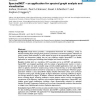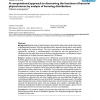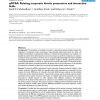65 search results - page 13 / 13 » Methods for Random Modularization of Biological Networks |
BMCBI
2004
13 years 4 months ago
2004
Background: Identifying protein-protein interactions is fundamental for understanding the molecular machinery of the cell. Proteome-wide studies of protein-protein interactions ar...
BMCBI
2006
13 years 4 months ago
2006
Background: Common fragile sites (cfs) are specific regions in the human genome that are particularly prone to genomic instability under conditions of replicative stress. Several ...
BMCBI
2005
13 years 4 months ago
2005
Background: Graph theory provides a computational framework for modeling a variety of datasets including those emerging from genomics, proteomics, and chemical genetics. Networks ...
BMCBI
2006
13 years 4 months ago
2006
Background: Phytochromes are photoreceptors, discovered in plants, that control a wide variety of developmental processes. They have also been found in bacteria and fungi, but for...
BMCBI
2007
13 years 4 months ago
2007
Background: The simulation of metabolic networks in quantitative systems biology requires the assignment of enzymatic kinetic parameters. Experimentally determined values are ofte...



